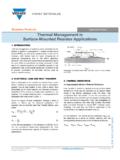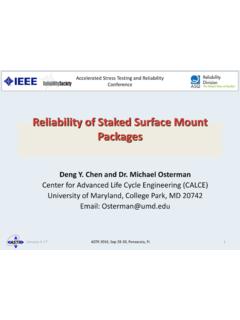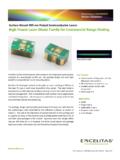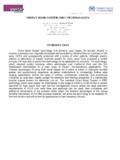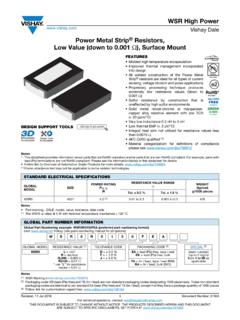Transcription of Thermal Management for Surface Mount …
1 V0 Thermal Management for Surface Mount Components 20 12 Hittite Microwave Corporation, All Rights Reserved. 2 Elizabeth Drive Chelmsford, MA 01824 Phone: 978-250-3343 Fax: 978-250-3373 Page 1 of 9 Thermal Management for Surface Mount Components General Application Note V0 Thermal Management for Surface Mount Components 20 12 Hittite Microwave Corporation, All Rights Reserved. 2 Elizabeth Drive Chelmsford, MA 01824 Phone: 978-250-3343 Fax: 978-250-3373 Page 2 of 9 Introduction As the power dissipation and availability of Surface Mount RF power amplifiers has increased, the need for careful Thermal Management of the next higher level assembly has become increasingly important.
2 Previous generation RF power amplifiers were generally available in flange Mount style packaging that inherently provided a mechanical and Thermal Mount for these devices directly to a metallic housing. However, these devices could not be Surface -mounted on a circuit board and, as a result, increased the product cost. Current generation RF power amplifiers are generally available in Surface - Mount QFN packages that can be attached to traditional PCB s via mature reflow soldering processes. With this new package style, the PCB now has to function not only as the RF interconnection between devices, but also the path to conduct heat away from the power amplifier.
3 The ability of the PCB to conduct heat depends directly on the materials, layout and design of the PCB. This application note will detail the methods needed to analyze the PCB design to ensure it will serve as an adequate Thermal interface between the RF power amplifier and the heat sink. Review of Thermal Concepts Heat Flow When a temperature difference exists across a material, heat will flow from the higher temperature areas to the lower temperature areas. This process is analogous to an electric current flowing through a circuit from higher potential (voltage) to lower potential.
4 Heat flow is measured in Watts and in electrical circuits is due to the conversion of electrical power (in Watts) to heat. Thermal Resistance All materials will conduct heat to some degree. The standard measure of the ability of materials to conduct heat is Thermal conductivity. Values of Thermal conductivity are typically specified in units ofKmW . Once the Thermal conductivity of a material is known, the Thermal resistance of a volume of that material can be calculated as: AreaKlength = (1) where: K = Thermal Conductivity (W/m- K) length = length (or thickness) of object (m) area = Cross sectional area (m2) Temperature Following the analog of an electrical circuit, the temperature difference T across a material with Thermal resistance and heat current Q flowing through it is.
5 = QT V0 Thermal Management for Surface Mount Components 20 12 Hittite Microwave Corporation, All Rights Reserved. 2 Elizabeth Drive Chelmsford, MA 01824 Phone: 978-250-3343 Fax: 978-250-3373 Page 3 of 9 where: T = Temperature difference ( K or C) Q = Heat current (W) = Thermal Resistance ( C/W or K/W) Interpretation of Hittite s Data Sheet Device Thermal Resistance Since the Thermal resistance of a system is complex and often non-linear with temperature, it is usually necessary to develop a Thermal model of the system using finite element analysis.
6 In addition, physical measurements of temperature using infrared photography are employed to determine the actual temperature of device junctions while operating. Based on these analyses and measurements an equivalent Thermal resistance can be determined under a specific set of conditions. This equivalent Thermal resistance is only valid under the specific conditions at which it was measured and is usually determined at the maximum operating temperature. The Thermal resistance of a device can be determined from the datasheet by converting the Thermal derating factor (in mW/ C) to a Thermal resistance in C/W.
7 A typical Absolute Maximum Ratings table is shown in Table 1. The device Thermal resistance is commonly represented by the symbol jc since it represents the Thermal resistance from the device junction (j) to package case (c). For QFN packages, the case is assumed to be the metallic slug on the bottom of the package. For non-slug packages, the case temperature is the foot of the leads. Absolute Maximum Ratings Supply Voltage (Vcc) + Vdc Control Voltage (Vpd) + Vdc Input Power (RFin) +20 dBm Channel Temperature 150 C Continuous Pdiss (T = 85 C) (derate mW/ C above 85 C) W Storage Temperature -64 to +150 C Operating Temperature -40 to +85 C Table 1 Absolute maximum ratings table From Table 1, the Thermal resistance is calculated as.
8 WCCmWjc = = Maximum Channel Temperature The maximum channel temperature is specified in the Absolute Maximum Ratings table for each product and depends on the particular process used for the device. For the example in Table 1, the maximum channel V0 Thermal Management for Surface Mount Components 20 12 Hittite Microwave Corporation, All Rights Reserved. 2 Elizabeth Drive Chelmsford, MA 01824 Phone: 978-250-3343 Fax: 978-250-3373 Page 4 of 9 temperature is specified at 150 C. Exceeding this maximum channel temperature will result in decreased life time and premature device failure.
9 This will be discussed later when considering component reliability. Operating Temperature Range The operating temperature range for the part is specified at the package base. It is the user s responsibility to ensure the part is in an environment capable of maintaining the temperature within the specified limits. Thermal Model of the Device and PCB Environment To fully understand the complete Thermal environment around the device, the various Thermal paths and materials must be analyzed. Figure 1 shows a cross sectional schematic of a typical QFN package mounted to a laminate PCB that is attached to a heat sink.
10 In this example, heat is being generated at the device junction (at the top of the DIE) and propagates down through the PCB and into the heat sink. Along this path there are several different materials and series/parallel Thermal paths to follow. In order to determine the ultimate temperature at the junction of the device, an equivalent Thermal resistance for the system must be calculated. This resistance, used in conjunction with the heat flow, will allow us to calculate the maximum junction temperature.










